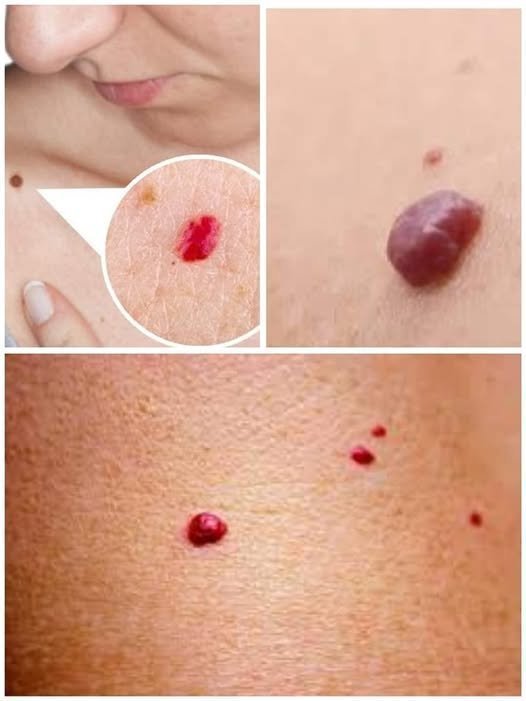ADVERTISEMENT
### **The Appearance of Red Moles**
Red moles have a distinct appearance, which makes them relatively easy to identify. They usually exhibit the following characteristics:
1. **Color**: They are most commonly red but may also appear purple or blue, especially when the blood vessels inside the mole are dilated.
2. **Shape**: Red moles are typically round or oval in shape.
3. **Size**: They can range from very small (about the size of a pinhead) to larger growths (1-2 cm or more).
4. **Texture**: These moles are usually smooth, although they may feel slightly raised.
5. **Location**: While they can appear anywhere on the body, red moles are most often found on the torso, arms, shoulders, or face.
Despite their noticeable color, red moles are typically painless, and they do not cause any discomfort unless irritated. It’s important to note that while red moles may look alarming due to their color, they are typically harmless.
### **What Causes Red Moles?**
The precise cause of red moles is not always well understood, but there are several factors that can contribute to their development. In general, red moles are thought to form as a result of the following:
1. **Excessive Blood Vessel Growth**: The most common cause of red moles is an overgrowth of blood vessels in a specific area of the skin. This causes the blood vessels to become dilated and form a small cluster, which manifests as a red or purple mole. This condition is known as cherry angiomas.
2. **Aging**: As people age, their skin undergoes changes that can lead to the development of red moles. They become more common with age, especially in individuals over 40. This is likely due to the cumulative effects of sun exposure, genetics, and changes in blood vessel function over time.
3. **Genetics**: Some individuals may be genetically predisposed to develop red moles. If you have a family history of cherry angiomas or similar skin conditions, you’re more likely to develop them yourself.
4. **Hormonal Changes**: Hormonal fluctuations, particularly those associated with pregnancy or certain medical treatments (such as hormone therapy), can contribute to the development of red moles. For example, women may notice an increase in the appearance of red moles during pregnancy.
5. **Environmental Factors**: Factors like excessive sun exposure, which can damage the skin and affect the blood vessels, may contribute to the appearance of red moles. UV radiation can trigger the formation of these moles in some individuals.
6. **Underlying Medical Conditions**: In some cases, red moles may be associated with underlying health conditions, particularly liver disease, diabetes, or other metabolic disorders. The presence of multiple red moles in a short period of time may indicate that further medical evaluation is needed.
—
### **When Should You Be Concerned About Red Moles?**
Although red moles are usually harmless, there are certain instances when they may require attention. In some cases, the sudden appearance of a large number of red moles, or changes in the size or shape of existing ones, could be a sign that something more serious is at play. Below are some scenarios in which you should be concerned and seek professional medical advice:
1. **Rapid Growth**: If a red mole grows rapidly or changes size quickly, it could be a cause for concern. While it’s common for cherry angiomas to grow slowly over time, any sudden change in size should prompt a visit to a dermatologist for an evaluation.
2. **Bleeding or Pain**: Red moles are usually painless, but if you notice that one begins to bleed, become inflamed, or become tender to the touch, it could be a sign of irritation or, in rare cases, infection. Any bleeding mole should be assessed by a healthcare professional.
3. **Changes in Color**: If the mole changes color, especially from red to black or brown, or if the color becomes uneven, it may indicate something more serious, such as melanoma. Skin cancers can sometimes mimic benign growths, so it’s important to have it checked.
4. **Multiple Moles in a Short Period**: The sudden appearance of a large number of red moles over a short period of time could indicate a medical issue, such as liver disease, thyroid dysfunction, or diabetes. If you notice many red moles appearing simultaneously, it’s important to consult with a healthcare provider.
5. **Family History**: If you have a family history of melanoma or other skin cancers, it’s always wise to have any new or changing moles checked by a dermatologist, even if they appear to be benign.
6. **Persistent Symptoms**: If you experience any discomfort, itching, or other symptoms associated with a red mole, it is important to have it assessed by a healthcare provider. While most red moles are harmless, any new or unusual symptoms warrant further investigation.
For Complete Cooking STEPS Please Head On Over To Next Page Or Open button (>) and don’t forget to SHARE with your Facebook friends
